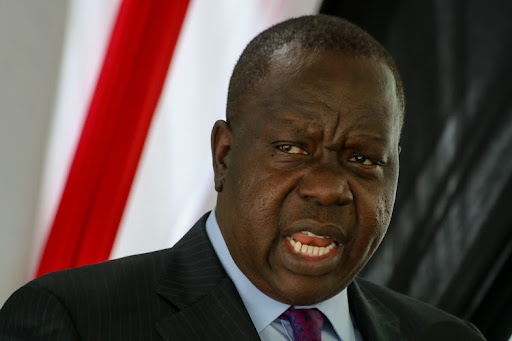The environment regulator has warned industries polluting the Athi Sabaki basin in Machakos county that they will be closed.
National Environment Management Authority director-general Mamo Mamo said most polluters are industries along Athi River.
"Those industries without effluent treatment discharge plants will be closed. We also have a compliance assistance programme to help companies comply," Mamo said.
He said enforcement action would be undertaken by Nema's 50 environmental inspectors deployed along Sabaki to ensure all discharge points are stopped.
The remarks followed a September visit to the basin by a multi-agency team
On September 29, a team comprising officers from the Environment ministry, Nema and Water Resource Authority went on a fact-finding mission to Athi Sabaki basin.
The team was led by Environment CS Keriako Tobiko, Mamo and Water Resource Authority quality manager Fred Nyongesa.
Armed with notebooks and equipment for sampling water, they boarded a chopper.
Their mission was to get a general understanding and overview of water quality and pollution status in the basin and formulate integrated approaches through a multi-agency Cabinet team.
The multi-agency team comprises ministries of Environment, Water, Sanitation, Agriculture, Interior, Lands and Physical Planning, Devolution, Tourism and National Treasury.
The focus was on Athi River, which is approximately 591km-long within the 37,750km2 Athi Basin. It is the second longest river in Kenya.
It gets water from Ngong Hills, Ondiri Wetland, Kinale, Kieni from which major rivers – Mbagathi, Ngong, Nairobi, Mathare, Ruiru and Ndarugu – flow from.
During the field visit, the team collected water samples for laboratory analyses from various sites.
The major sites included Fourteen Falls downstream in Kilimambogo town on the slopes of Ol Donyo Sabuk National Park, Thwake Dam, National Irrigation Authority water works construction site and Galana Kulalu project.
At Fourteen Falls, which is used as a water sport, tourist and recreational site, the team found out that the site was self-cleansing and had improved water quality.
The self-cleansing is due to natural water turbulence.
Approximately 30 kilometres from Fourteen Falls is Kalawa area, where there was a construction site – probably for water abstractions. The team said the site is a case for further follow up. The quality of water at the site, however, appeared visibly good.
The team proceeded to Thwake Dam, which is located about 500 metres downstream of rivers Athi and Thwake.
They found out that while Athi River has water, Thwake River was dry. The two rivers is where water for Thwake Dam will be harnessed from. The four-phase Thwake Dam is expected to change the lives of 1.3 million residents of Makueni, Kitui and Machakos counties.
Phase one, which is ongoing, involves the construction of an 87-metre-high dam wall with 688 million cubic metre storage capacity.
Phase two will involve the installation of a hydropower generation plant while phase three comprises the installation of water supply, sanitation and waste water infrastructure.
The fourth phase will be the development of the irrigation component. The dam construction work was in progress.
Approximately 20-km downstream of Thwake Dam, there was another construction site overseen by G.L. Williams Ltd as the contractor for the National Irrigation Authority as the proponent.
"The prerequisite Nema licence and WRA authorisation could not be produced by the contractor at the site. This is also a case for follow up," the team said.
At this site, the water appeared greenish and with significantly reduced quantity.
At Galana Kulalu Food Security Project, the Galana river is canalised through an unlined 2-km channel to the water intake chambers from where it is pumped and passed through the filtration units for use on crops and livestock.
However, there is a shallow well, approximately 26 feet below the surface level, at the Ndovu camp, whose water is used for other uses and not preferred for drinking as it is salty.
At Dwa Estate Ltd, a facility dealing with the growth and processing of sisal products, the team found a huge heap of waste products. The team said they would also follow up on this case.
The team said the river water appeared murky up to about 5-km before the Fourteen Falls.
"The water at 10m upstream of Fourteen Falls appeared clearer and indicated presence of heavy metals – lead and cadmium – above the allowable water quality levels of 0.05 and 0.01 mg/l respectively," the team said.
About 15 km downstream of Thwake Dam, the river water started appearing greenish, the appearance persisted for the remaining stretch up to Galana Kulalu.
"Greenish colouring could be associated with algae growth due to nutrients and sisal processing juice. Further investigations that include anthropogenic activity and soil analysis are recommended."
The team said it is necessary to resample and analyse for pollution indicator parameters that include pH, total phosphorus, total nitrates, petroleum products, heavy metals, pesticides and detergents.
The team said streams, rivers, dams, lakes and oceans are more vulnerable to pollution than groundwater bodies.
However, pollution is more present in rivers traversing urban centres. In the upstream sources of rivers, the water is clean but the quality starts to deteriorate as the rivers flow through urban areas.
The team will now seek to clean and improve water quality of the Athi River to satisfactorily support environmental, social and economic developments for the present and future.











